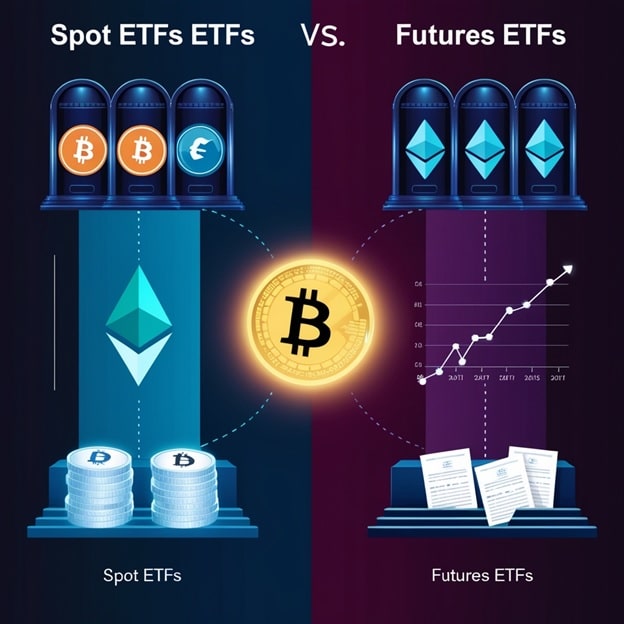Crypto ETFs have brought about an important step in how cryptocurrency is invested. Crypto ETFs make it possible for more investors to be part of the crypto market by using exchange-traded funds, without having to own cryptocurrencies themselves.
Crypto ETFs are expected to reach a major turning point in 2025. As regulations become clearer, more institutions join the market, and investors show more interest, 2025 will bring both new chances and difficulties to the crypto ETF area. The events of this year could decide how popular these products are and how they will affect the future of investing in digital assets.
This guide will go over the main things investors should know about Crypto ETFs in 2025. We will discuss what benefits and risks come with Crypto ETFs, review the current rules, point out the leading Crypto ETFs, and give advice to help investors choose wisely.
What Are Crypto ETFs?
Crypto ETFs are funds that follow the price of cryptocurrencies and can be traded on traditional stock markets, just as regular ETFs. Rather than owning actual cryptocurrencies, investors can invest in a Crypto ETF to gain access to the digital asset market without worrying about wallets or keys.
There are two main categories of Crypto ETFs to learn about.
- Spot ETFs: The funds in these accounts actually contain the cryptocurrencies, such as Bitcoin and Ethereum. The fund’s value changes in the same way as the actual market price of the coins it owns.
- Futures ETFs: They do not buy the coins, but rather bet on the future prices of cryptocurrencies through contracts. Futures ETFs are tied to the future prices of cryptocurrencies, but they may not act like the spot market because of contract expirations and fees.
Crypto ETFs are different from traditional ETFs since they only invest in digital assets, unlike those focusing on stocks, bonds, or commodities. Traditional ETFs usually track popular markets, but Crypto ETFs belong to a newer, more unpredictable area. At the same time, they make it possible for investors to access cryptocurrencies in a regulated and convenient way.
Why Crypto ETFs Are Gaining Popularity in 2025
In the year 2025, a lot of investors are paying close attention to Crypto ETFs to gain a diversified position in the expanding crypto market. Purchasing Crypto ETFs is riskier than getting single cryptocurrencies because they offer exposure to many cryptocurrencies at once and may still give good returns.
Authorities like the U.S. SEC and others from around the globe have made it easier for investors with their increased regulatory clarity, which has strongly contributed to the rise in popularity of Crypto EFTs. Well-defined rules and guidelines have earned the trust of investors, so Crypto ETFs have become more secure and easier to use for both big and small investors.
Besides, having large financial firms and asset managers take part in Crypto ETFs has lent these products more credibility. It becomes clear that the market is growing when big companies in banking and investing enter the Crypto ETF space, offering a more solid foundation for Crypto ETFs in the coming years.
Top Performing Crypto ETFs to Watch in 2025
Because of the rise of crypto ETFs in 2025, several leading funds now offer investors different opportunities to invest in cryptocurrencies. Some examples of strong ETFs are mentioned below.
- Bitcoin (BTC) ETFs: Most of these funds make investments guided by the changing price of Bitcoin. Those who wish to track Bitcoin’s movement can use an ETF instead of buying the coin directly.
- Ethereum (ETH) ETFs: Because of the development of more decentralized applications in Ethereum and its large ecosystem, ETH ETFs are becoming more popular, supplying investors a chance to invest.
- Diversified Crypto Basket ETFs: They include investments in various cryptocurrencies, for example, Cardano, Solana, and Polkadot. When you spread your money through such funds, you can benefit from both minimal risks and progress in multiple segments of the cryptocurrency market.
While assessing Crypto ETFs, check the past returns and fluctuations and see what types of assets the fund contains. Important things to check are administration expenses, the number of assets being managed, how easily the fund can be traded, and the way it is constructed (spot ETF vs futures ETF).
Considering all these points, investors are able to choose Crypto ETFs appropriate for them and what they want to achieve.
Risks and Volatility in Crypto ETFs
Even though ETFs made from crypto are a comfortable investment option, investors should still consider their potential risks.
First, cryptocurrencies usually experience greater price and market changes than most assets. So, Crypto ETFs’ values might swing widely, allowing short-term changes in their investors’ earnings.
Likewise, rules and regulations are still causing a big challenge. Because even a small change in the policies of major governments can change the rules affecting Crypto ETFs, more clarity brought in 2025 is still not enough. Receiving updates about changes in law is essential for people who own stocks.
It is also possible for problems with handling assets to emerge, mainly in the case of spot ETFs that own actual crypto currencies. Things such as hacking, theft, or mismanaging digital assets give rise to security risks, and people placing their money in ETFs trust their providers to keep their investments secure.
You need to understand the risks involved before taking part in Crypto ETFs and handling any related downsides better.
Benefits of Investing in Crypto ETFs
There are several benefits to choosing Crypto ETFs instead of buying cryptocurrencies by yourself.
An important advantage is that it costs less to enter. When investors use crypto ETFs, they get access to digital assets without learning how to manage their keys or wallets. For this reason, both new and traditional investors can now join the crypto market more comfortably.
As a plus point, investing in Crypto ETFs ensures you can track your assets and exchange them quickly. Because these funds are traded on stock exchanges, investors can make trades at any point during trading hours, unlike some cryptocurrencies that can at times be less easily bought or sold.
As an additional benefit, Crypto ETFs are regulated, which brings greater security and control than with direct crypto transactions. The rules in place offer protection to investors and give a sense of security, the reason why those concerned about investing in plain crypto find Crypto ETFs appealing.
How to Choose the Right Crypto ETF
To choose the correct Crypto ETF, you should consider your aims in investing as well as how risky you wish to be.
At the beginning, check how much risk you can take. The assets managed by a crypto ETF can cause their volatility to change a lot. In this way, having an entire crypto basket in an ETF may make that ETF behave differently in terms of risk than one that invests only in Bitcoin.
Then, pay attention to the fees that will be charged for the ETF. Since management charges and other fees matter, I suggest checking them before making your decision.
Review the list of assets in the ETF to know which cryptocurrencies are included and how much weight each one has. This way, you will learn about the ETF’s risks and what factors affect its performance.
Another aspect to think about is the way the ETF is built. Some hold real cryptocurrency, and others follow derivative contracts. Every approach has its own special benefits and possible dangers.
Keep in mind how many years you want to keep your investment. Are you planning to keep your cryptocurrencies long-term for growth, or are you looking at making profits from short-term changes in the market? Different strategies may display different sets of ETFs as the right ones.
Lastly, check comparison sites and platforms made for ETFs. Sites such as ETF.com and the research tools of financial brokers help you analyze anything from detailed information to past performance and fees.
Tax Implications and Regulatory Landscape in 2025
In 2025, any investor must be aware of the taxes and rules applied to Crypto ETFs.
Laws are not the same everywhere and show big differences in the United States, European Union, and Asia regions. Clear regulation about Crypto ETFs and their taxes has been made available to people in the US by bodies like the SEC and IRS. Likewise, the EU is making regulations for crypto investment products, but Asian nations are still figuring out the right approach.
The way governments view Crypto ETFs tends to vary according to their framework. A few people treat crypto ETPs the way they do other ETFs, while others see them differently and apply special tax rules for crypto users. They could be required to pay capital gains taxes, dividend taxes, or such fees depending on the rules where the ETF is registered and its own rules.
To manage investment properly and avoid payments, it is essential to obey local laws. Those investing in cryptocurrency should monitor their activities, learn what should be reported, and maybe hire professionals who understand these investments.
Having knowledge about updates and expectations in tax and rules will give investors more confidence when dealing with Crypto ETFs in 2025.
Expert Predictions and Market Outlook for Crypto ETFs
It is expected by industry experts that the Crypto ETF market will expand a lot in 2025. As regulations become stronger, experts think that more investors will feel assured, which should increase the number of those adopting cryptocurrencies. Because there are now Crypto ETFs that cover major coins as well as groups of different currencies, it’s anticipated that the number of market participants will expand.
Lately, both tokenization and decentralized finance (DeFi) have influenced the rising trend of ETFs. It is predicted that experienced investors will see ETFs that buy DeFi protocols or tokens representing various real-world assets, thus giving them a way to invest in fledgling areas of crypto.
A number of analysts think 2025 could play a key role in the adoption of cryptocurrencies by institutions. Increasingly, large financial firms, hedge funds, and pension funds are adding Crypto ETFs to their portfolios because they are trustworthy and convenient. If more institutions get involved, it could make the cryptocurrency market stronger and give Crypto ETFs a more solid status in the future.
Beginner Tips for Investing in Crypto ETFs
When you begin investing in Crypto ETFs, starting in the correct manner can let you avoid risks and gain confidence.
First, invest only a little money and spread your investments around. You should place your investments in several ETFs or different asset classes to limit your risk.
It is important to choose brokers or platforms that people trust and follow all regulations. When your provider is reliable, your investments stay safe and you get true information and help at any time.
Also, don’t forget to regularly follow changes and news about the crypto industry. Since the cryptocurrency field changes fast, being updated about new rules, trends, and technology will help you invest wisely.
Conclusion
Crypto ETFs in 2025 show both possible gains and real hazards. Investors can experience the growth in the crypto market by using products that are like standard financial products. Nevertheless, since cryptocurrencies are highly volatile, the regulations may change, and there are problems with their management, proper consideration and risk management are necessary.
As crypto ETFs keep developing rapidly, it’s necessary for investors to think carefully and choose the right ones, according to what they want and how much risk they are prepared to take.
Since new developments in cryptocurrency occur quickly, people need to keep up with new information to succeed in the field.





































